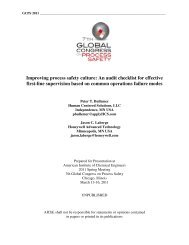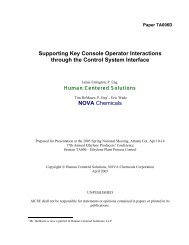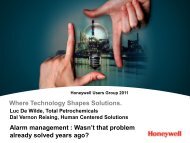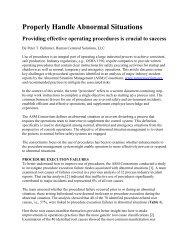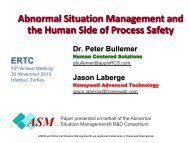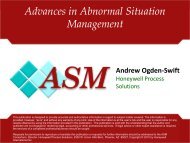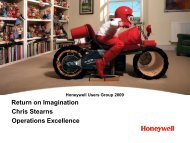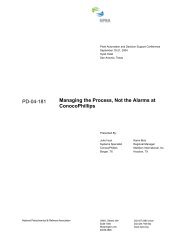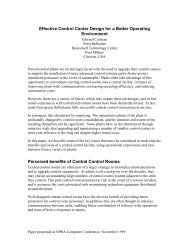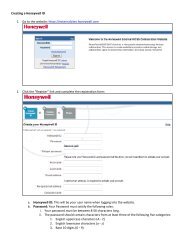ASM Display Guidelines - ASM Consortium
ASM Display Guidelines - ASM Consortium
ASM Display Guidelines - ASM Consortium
You also want an ePaper? Increase the reach of your titles
YUMPU automatically turns print PDFs into web optimized ePapers that Google loves.
An Introduction to the <strong>ASM</strong> <strong>Guidelines</strong>Effective Operator <strong>Display</strong> Design2009 <strong>ASM</strong> WebinarCommunications Program<strong>ASM</strong>Dal Vernon ReisingPeter BullemerHuman Centered SolutionsHelping People Performwww.applyHCS.comThis document and the information contained herein are confidential to the <strong>ASM</strong> <strong>Consortium</strong> and the property of Honeywell International, and aremade available only to <strong>ASM</strong> <strong>Consortium</strong> member company employees. This document, and any copy thereof, and the information containedherein shall be maintained in strictest confidence; shall not be disclosed or distributed (a) to persons who are not <strong>ASM</strong> <strong>Consortium</strong> employees, or(b) to <strong>ASM</strong> <strong>Consortium</strong> employees for whom such information is not necessary in connection with their assigned responsibilities. When theemployee in possession of this document terminates employment with the <strong>ASM</strong> member company, this document and any copies thereof shallbe returned to the employee’s manager. There shall be no exceptions to the terms and conditions set forth herein except as authorized in writingby the responsible <strong>ASM</strong> Program Manager in accordance with the provisions of the <strong>ASM</strong> <strong>Consortium</strong> Agreement.Page 1<strong>ASM</strong> <strong>Consortium</strong> Proprietary<strong>ASM</strong>-HCS Interaction Reqts Webinar.ppt
<strong>ASM</strong>Webinar Presenters• Dr. Dal Vernon Reising– Senior partner, HCS, human factors consulting group– Ph.D. in Industrial Engineering– Participation in <strong>ASM</strong> program since 1999, including roleas Principal Investigator• Dr. Peter Bullemer– Senior partner, HCS, human factors consulting group– Ph.D. in Cognitive Science– Participation in <strong>ASM</strong> program since 1993, including rolesas Director and Principle InvestigatorPlease mute your phone when not speaking to the webinar. (Mute button or *6* to mute and *6* to un-mute)Page 2<strong>ASM</strong> <strong>Consortium</strong> Proprietary<strong>ASM</strong> and Abnormal Situation Management are U.S. registered trademarks of Honeywell International, Inc.Human Centered SolutionsHelping People Performwww.applyHCS.com
<strong>ASM</strong>Poll Slide 1 (Placeholder)• How would you characterize your current employer inthe industry?– Operating company site– Operating company corporate– Consultant– Engineering firm– DCS vendor company– Advanced applications / tools vendor company– OtherPlease mute your phone when not speaking to the webinar. (Mute button or *6* to mute and *6* to un-mute)Page 3<strong>ASM</strong> <strong>Consortium</strong> Proprietary<strong>ASM</strong> and Abnormal Situation Management are U.S. registered trademarks of Honeywell International, Inc.Human Centered SolutionsHelping People Performwww.applyHCS.com
<strong>ASM</strong>Poll Slide 2 (Placeholder)• What is your experience level with the <strong>ASM</strong>®“Effective Operator <strong>Display</strong> Design” guidelinesdocument?– Only heard about it, but don’t know much about it– Have not read it, but have seen “<strong>ASM</strong> display” examplesbefore– Skimmed through the document– Read it from cover to cover– Used the document in the context of my workPlease mute your phone when not speaking to the webinar. (Mute button or *6* to mute and *6* to un-mute)Page 4<strong>ASM</strong> <strong>Consortium</strong> Proprietary<strong>ASM</strong> and Abnormal Situation Management are U.S. registered trademarks of Honeywell International, Inc.Human Centered SolutionsHelping People Performwww.applyHCS.com
<strong>ASM</strong>Abnormal Situation Management®A Joint Research and Development <strong>Consortium</strong>Founded in 1994Creating a new paradigmfor the operation ofcomplex industrial plants,with solution conceptsthat improve Operations’ability to prevent andrespond to abnormalsituations.www.asmconsortium.org® Abnormal Situation Management and <strong>ASM</strong> are US registered trademarks of Honeywell Inc.Please mute your phone when not speaking to the webinar. (Mute button or *6* to mute and *6* to un-mute)Page 5<strong>ASM</strong> <strong>Consortium</strong> Proprietary<strong>ASM</strong> and Abnormal Situation Management are U.S. registered trademarks of Honeywell International, Inc.Human Centered SolutionsHelping People Performwww.applyHCS.com
<strong>ASM</strong>What is an Abnormal Situation?An industrial process is being disturbed and theautomated control system can not cope...Consequently, the operations team mustintervene to supplement the control system.Impacts profitability in multiple ways:Product QualityEquipment DamageLoss of LifeJob SatisfactionProduct ThruputPersonal InjuryPlease mute your phone when not speaking to the webinar. (Mute button or *6* to mute and *6* to un-mute)Page 6<strong>ASM</strong> <strong>Consortium</strong> Proprietary<strong>ASM</strong> and Abnormal Situation Management are U.S. registered trademarks of Honeywell International, Inc.Human Centered SolutionsHelping People Performwww.applyHCS.com
3 0 02 5 02 0 01 5 01 0 05 03002502001501000500457463468474480486492497503509515Production rate520Feed R a te5265325385435495555615675725785845901503595<strong>ASM</strong>Making the Business CaseUnexpected Events Cost 3-8% of Capacity1121151181211243.2%5.8%5.8%127130133136139142145148151154157160163166169172174177180183~ $10 Billion annually in lost production !Source: <strong>ASM</strong> <strong>Consortium</strong> Research2 σ$24.2M24.2M1 σ181614121086420Total Feed$38.5 M38.5MPlant Operating Target20151028029030031032033034035036037038039040041042033.5M $33.5 M430440450460Total Feed47048049050051052053054055056057058059060061062050280290300310320330340350360370380390400410420430440450460470480490500510520530540550560570580590600RateSummarized Production Data610620Operational ConstraintsDays per YearPlant IncidentsOptimization effortsPlant Capacity LimitPlease mute your phone when not speaking to the webinar. (Mute button or *6* to mute and *6* to un-mute)Page 7< 60%Daily Production Level<strong>ASM</strong> <strong>Consortium</strong> Proprietary<strong>ASM</strong> and Abnormal Situation Management are U.S. registered trademarks of Honeywell International, Inc.95% 100%Human Centered SolutionsHelping People Performwww.applyHCS.com
<strong>ASM</strong>Webinar Overview• This webinar aims to– Present a case study on thevalue of “<strong>ASM</strong> graphics”– Introduce people to the contentsof Effective Operator <strong>Display</strong>Design guidelines document– Discuss some common pitfalls inusing guidelines– Suggest how the documentmight be usedPlease mute your phone when not speaking to the webinar. (Mute button or *6* to mute and *6* to un-mute)Page 8<strong>ASM</strong> <strong>Consortium</strong> Proprietary<strong>ASM</strong> and Abnormal Situation Management are U.S. registered trademarks of Honeywell International, Inc.Human Centered SolutionsHelping People Performwww.applyHCS.com
<strong>ASM</strong>Purpose and Scope• Communicate the <strong>ASM</strong>® <strong>Consortium</strong>recommendations for the effective design and use ofoperator graphics and field device displays• Enable assessment of the quality of a company’soperator displays and console configuration from theperspective of their potential impact on abnormalsituation management• While this document does describe “what to do,” it is not intended tobe a “how to guide” to the design of the plant policy or workprocesses• Examples are provided in the Guideline book to help explain theguidelines, but the examples might NOT provide the bestimplementation for your sitePlease mute your phone when not speaking to the webinar. (Mute button or *6* to mute and *6* to un-mute)Page 9<strong>ASM</strong> <strong>Consortium</strong> Proprietary<strong>ASM</strong> and Abnormal Situation Management are U.S. registered trademarks of Honeywell International, Inc.Human Centered SolutionsHelping People Performwww.applyHCS.com
<strong>ASM</strong>Guideline Development• Operator interface design has been an important focus of the <strong>ASM</strong><strong>Consortium</strong> since its origin in 1994• During the NIST-funded Phase of the <strong>Consortium</strong> (1996-1998)– Conducted site practice assessments, identifying best practices including thosefor operator graphics and display design– Prototyped an advanced information system (AEGIS) that applied pacesetterconcepts to operator graphics• Drafted initial guidelines document in 2000, based on site practices• Conducted an Operator Graphics Workshop in Fall 2000 to identifyadditional practices and solicit feedback on guidelines• Published document for <strong>ASM</strong> member use in 2000– Project Team—Honeywell Labs, <strong>Consortium</strong> User Members &workshop attendees– Critical Review Team—<strong>ASM</strong>C User Members• Major refinements to the document in 2003, 2004, 2007 and 2009Please mute your phone when not speaking to the webinar. (Mute button or *6* to mute and *6* to un-mute)Page 10<strong>ASM</strong> <strong>Consortium</strong> Proprietary<strong>ASM</strong> and Abnormal Situation Management are U.S. registered trademarks of Honeywell International, Inc.Human Centered SolutionsHelping People Performwww.applyHCS.com
<strong>ASM</strong>Some Initial <strong>ASM</strong> ConceptsTrend WindowStatus WindowWaste Heat175#AtmosphereSteamTrend WindowFeed PreheatFractionator-35Riser/RegeneratorDocumentation Task Window- 45Goals/Plans/Actions WindowSpecifications onThings-35-15+102-35•malfunction•goals•alarms•plan 1 status•plan 2 status•plant3 status•This is aCombustion Air•message•plan 4 status• string of text•plan 5 status•Describing s•stuff-10Feed PreheatCombustion Riser/RegenAirFractiona Waste torHeatXOv erheadH NaphthaLCOHCOFeed PreheatCombustion Riser/RegenAirFractionatorWaste HeatOverheadH NaphthaLCOHCOAuto FilterEmergencyACKStatus Time/DateAgeTypeEvidence ResponseSource10:14:34 12/15/9600:00TripNotifications Window Operations Window Operations WindowDiagnostic Window10:14:34 12/15/9600:00Request10:14:34 12/15/9600:15PVDEVHITrendAdvisoryLogHistoryActive UINUIN Library ChronicAlarms9:44:34 12/15/96NameRalph15 RalphAuthorFIDevOverhead Receiver Pressur e PC204JoeTimeJoe FRemind14100Anna5AnnaTimerRalph6RalphFIDevRalph4RalphRemind80Ralph2RalphTIChng13Anna1AnnaTIChng60PV SP OP1230 Minute40ControlNoteLogSpecsConfigureEvidenceReceiverCompressorRefluxControlNoteLogSpecsConfigureEv ReceiveridenceCompressorRefluxIntervene InvestigateWatch...201100Deactivate New >>Edi t>>Objective• Define <strong>ASM</strong>-based user interfaceconcepts and features that improveusability and effectiveness of thehuman-machine interactions in theprocess control operationsenvironmentKey Solution Concepts & Innovations• Single, Integrated View of Multi-Level Hierarchy• Mixed Initiative Approach• Effective Window Management and Layout• Effective Navigation Scheme• Visual Coding Scheme• Interaction Objects• Contextual Menus & Information presentation• Task View OrganizationPlease mute your phone when not speaking to the webinar. (Mute button or *6* to mute and *6* to un-mute)Page 11<strong>ASM</strong> <strong>Consortium</strong> Proprietary<strong>ASM</strong> and Abnormal Situation Management are U.S. registered trademarks of Honeywell International, Inc.Human Centered SolutionsHelping People Performwww.applyHCS.com
<strong>ASM</strong>The Instantiation of the initial <strong>ASM</strong>Operator Interface ConceptFor Proactive Monitoring:• Simultaneous, integrated view ofincreasing plant detail• Integrated Trending• Integrated alarm management intographics and navigation tabsFor Fast Response:• Multi-windowing with controlledwindow management• “Yoked” navigation between displaylevels• Tabbed navigation within a displaylevel• Graphics design– e.g., Color-coding only for critical information – like alarms, No 3D graphicalobjects, etc.• Right-mouse click access to online documentation– e.g., Alarm Objective Analysis documents, procedures, etc.Please mute your phone when not speaking to the webinar. (Mute button or *6* to mute and *6* to un-mute)Page 12<strong>ASM</strong> <strong>Consortium</strong> Proprietary<strong>ASM</strong> and Abnormal Situation Management are U.S. registered trademarks of Honeywell International, Inc.Human Centered SolutionsHelping People Performwww.applyHCS.com
<strong>ASM</strong><strong>ASM</strong>-style Operator InterfaceCase StudyTraditional Console Simulatorvs.<strong>ASM</strong>-style <strong>ASM</strong>-Style Console SimulatorU UGUG UGUGGGGPCPCG GPlease mute your phone when not speaking to the webinar. (Mute button or *6* to mute and *6* to un-mute)Page 13<strong>ASM</strong> <strong>Consortium</strong> Proprietary<strong>ASM</strong> and Abnormal Situation Management are U.S. registered trademarks of Honeywell International, Inc.Human Centered SolutionsHelping People Performwww.applyHCS.com
<strong>ASM</strong>Case Study ResultsPre-Test ResultsGroup Comparison Metrics• No average differences betweenthe two groups of operators for:– Years of experience as anoperator– Years of experience as anoperator at this company– Years of experience as aconsole operator– # of process areas qualifiedin<strong>ASM</strong> StylePlease mute your phone when not speaking to the webinar. (Mute button or *6* to mute and *6* to un-mute)Page 14<strong>ASM</strong> <strong>Consortium</strong> Proprietary<strong>ASM</strong> and Abnormal Situation Management are U.S. registered trademarks of Honeywell International, Inc.Human Centered SolutionsHelping People Performwww.applyHCS.com
<strong>ASM</strong>Case Study ResultsScenario Evaluation ResultsOperator performance measure: Total Completion Time• The operators using the <strong>ASM</strong>styleinterface tooksignificantly less time to dealwith the event and as a group,were more consistent indoing so!– An average of 10.6 minutesvs. 18.1 minutes for thoseusing the traditional console– A 41% improvementTraditional<strong>ASM</strong>-StyleStylePlease mute your phone when not speaking to the webinar. (Mute button or *6* to mute and *6* to un-mute)Page 15<strong>ASM</strong> <strong>Consortium</strong> Proprietary<strong>ASM</strong> and Abnormal Situation Management are U.S. registered trademarks of Honeywell International, Inc.Human Centered SolutionsHelping People Performwww.applyHCS.com
<strong>ASM</strong>Case Study Results• Detecting the event BEFOREthe first alarmScenario Evaluation ResultsOperator performance measures:– On average, operators usingthe <strong>ASM</strong>-style interfacedetected an event before thealarm 48% of the time– A 38% improvementInterface TypeScenarioTraditional Human-centered<strong>ASM</strong>-style1 0% 27%2 10% 82%3 10% 82%4 20% 0%Mean 10.0% 47.7%• Successful completion of thescenario– On average, operators usingthe <strong>ASM</strong>-style interfacesuccessfully dealt with thesituation 96% of the time– A 26% improvementScenarioInterface TypeTraditional Human-centered<strong>ASM</strong>-style1 60% 100%2 70% 100%3 80% 91%4 70% 91%Mean 70.0% 95.5%Please mute your phone when not speaking to the webinar. (Mute button or *6* to mute and *6* to un-mute)Page 16<strong>ASM</strong> <strong>Consortium</strong> Proprietary<strong>ASM</strong> and Abnormal Situation Management are U.S. registered trademarks of Honeywell International, Inc.Human Centered SolutionsHelping People Performwww.applyHCS.com
<strong>ASM</strong>Economic Impact Estimation• The estimated total economic savings for the unit with thetraditional console (a 1.8 Blb/year ethylene plant), were it to adopt the<strong>ASM</strong>-style interface was– On average, $1,090K CAD/year (~$870K USD/year, circa 2005)– The median (considered most likely) was $1,000K CAD/year(~$800K USD/year, circa 2005)Please mute your phone when not speaking to the webinar. (Mute button or *6* to mute and *6* to un-mute)Page 17<strong>ASM</strong> <strong>Consortium</strong> Proprietary<strong>ASM</strong> and Abnormal Situation Management are U.S. registered trademarks of Honeywell International, Inc.Human Centered SolutionsHelping People Performwww.applyHCS.com
<strong>ASM</strong><strong>ASM</strong> Supervisory Control Model• Based on traditional Human Information Processing model• Includes Psychological stages of Situation AwarenessProcessStateOperator Mental & Physical ActivitiesOrientingEvaluatingActingInputs from Process(sensors, analyzers, radios,video, instructions, sounds &smells)(1) Sensing,Perception,and/orDiscrimination(2) Analysis,Interpretation,and/or(3) ProjectionPhysical and/orVerbalResponseOutputs to Process(SP, OP%, Manualadjustments)Situation Awareness (1-3)Internal FeedbackAssessingExternal FeedbackPlease mute your phone when not speaking to the webinar. (Mute button or *6* to mute and *6* to un-mute)Page 18<strong>ASM</strong> <strong>Consortium</strong> Proprietary<strong>ASM</strong> and Abnormal Situation Management are U.S. registered trademarks of Honeywell International, Inc.Human Centered SolutionsHelping People Performwww.applyHCS.com
<strong>ASM</strong>Managing Abnormal SituationsSome Influences on Intervention SuccessOrienting• Informationoverload• Missing information• Inappropriate levelof detail• Vigilance decrement• Difficult navigation• DistractingenvironmentEvaluating• Inconsistentinformation• Inaccurateinformation• Conflicting priorities• Lack of knowledge• Inappropriate detail• Poor informationaccessibilityActing• Inadequatecommunications• Deficient / complexprocedures• Fail to followprocedures• Inappropriate actions• Lack of experience• Inadequate feedbackAssessing• Lack “big picture”view• Inaccurateinformation• Inadequateinformation• ErroneousconclusionsPlease mute your phone when not speaking to the webinar. (Mute button or *6* to mute and *6* to un-mute)Page 19<strong>ASM</strong> <strong>Consortium</strong> Proprietary<strong>ASM</strong> and Abnormal Situation Management are U.S. registered trademarks of Honeywell International, Inc.Human Centered SolutionsHelping People Performwww.applyHCS.com
<strong>ASM</strong>Effective Operator <strong>Display</strong> DesignDocument Overview• Sixteen Guideline Categories– <strong>Display</strong> Types, <strong>Display</strong> Content, <strong>Display</strong> Style,<strong>Display</strong> Layout– Color, Symbols and Process Connections, Textand Numbers– Navigation, Interaction and <strong>Display</strong>s– Alarm Configuration Scheme, AudibleAnnunciation for Alarms, Visual Annunciationfor Alarms– Training Program, Online Guidance, DesignMethodology, Management of Change• 81 guidelines in total across these 16categories• <strong>Guidelines</strong> are prioritized– Priority “1” – rated as one of the minimum set ofguidelines for achieving an <strong>ASM</strong> good quality practice.– Priority “2” – one of the comprehensive set ofguidelines for achieving an <strong>ASM</strong> high quality practice.– Priority “3” – one of the advanced set of guidelines forachieving an <strong>ASM</strong> best practicePlease mute your phone when not speaking to the webinar. (Mute button or *6* to mute and *6* to un-mute)Page 20<strong>ASM</strong> <strong>Consortium</strong> Proprietary<strong>ASM</strong> and Abnormal Situation Management are U.S. registered trademarks of Honeywell International, Inc.Human Centered SolutionsHelping People Performwww.applyHCS.com
<strong>ASM</strong>Guideline Structure – p. 16.1 Use a minimum of color codes consistentlyacross display hierarchy levels.Priority 1Why?How it WorksConsistent, distinguishable color codes allow operators to learn the codes and themeaning behind them.The number of colors used to code categories of objects should be kept to seven orless, and be consistently applied. Seven corresponds to the number of items thatcan generally be kept in short term memory (Wickens and Hollands, 1999). Theseven color codes do not limit the coding of other information separate from thecategory information. For example, an unacknowledged, high alarm could be abrighter, more saturated yellow, which is distinct from an acknowledged high alarmthat would be a paler, less saturated yellow. These two ‘states’ of high alarms aredistinct from red color-coded emergency alarms, which are either more or lesssaturated depending on their state of acknowledgement.In general, color coding to indicate materials in process lines is not recommended innormal display view because it can draw the operator’s attention away from morecritical information. If one insists on showing lines colored based on material theycontain, then colors should be implemented such that they can be toggled on and off(or show this representation in a view generated by the IT system supporting theplant).Please mute your phone when not speaking to the webinar. (Mute button or *6* to mute and *6* to un-mute)Page 21<strong>ASM</strong> <strong>Consortium</strong> Proprietary<strong>ASM</strong> and Abnormal Situation Management are U.S. registered trademarks of Honeywell International, Inc.Human Centered SolutionsHelping People Performwww.applyHCS.com
<strong>ASM</strong>Guideline Structure – p. 16.1 Use a minimum of color codes consistently acrossdisplay hierarchy levels.Priority 1Why?How it WorksConsistent, distinguishable color codes allow operators to learn thecodes and the meaning behind them.The number of colors used to code categories of objects should be kept to seven orless, and be consistently applied. Seven corresponds to the number of items thatcan generally be kept in short term memory (Wickens and Hollands, 1999). Theseven color codes do not limit the coding of other information separate from thecategory information. For example, an unacknowledged, high alarm could be abrighter, more saturated yellow, which is distinct from an acknowledged high alarmthat would be a paler, less saturated yellow. These two ‘states’ of high alarms aredistinct from red color-coded emergency alarms, which are either more or lesssaturated depending on their state of acknowledgement.In general, color coding to indicate materials in process lines is not recommended innormal display view because it can draw the operator’s attention away from morecritical information. If one insists on showing lines colored based on material theycontain, then colors should be implemented such that they can be toggled on and off(or show this representation in a view generated by the IT system supporting theplant).Please mute your phone when not speaking to the webinar. (Mute button or *6* to mute and *6* to un-mute)Page 22<strong>ASM</strong> <strong>Consortium</strong> Proprietary<strong>ASM</strong> and Abnormal Situation Management are U.S. registered trademarks of Honeywell International, Inc.Human Centered SolutionsHelping People Performwww.applyHCS.com
<strong>ASM</strong>Guideline Structure – p. 16.1 Use a minimum of color codes consistently acrossdisplay hierarchy levels.Priority 1Why?How it WorksConsistent, distinguishable color codes allow operators to learn the codes and themeaning behind them.The number of colors used to code categories of objects should be kept toseven or less, and be consistently applied. Seven corresponds to the numberof items that can generally be kept in short term memory (Wickens andHollands, 1999). The seven color codes do not limit the coding of otherinformation separate from the category information. For example, anunacknowledged, high alarm could be a brighter, more saturated yellow,which is distinct from an acknowledged high alarm that would be a paler, lesssaturated yellow. These two ‘states’ of high alarms are distinct from red colorcodedemergency alarms, which are either more or less saturated dependingon their state of acknowledgement.In general, color coding to indicate materials in process lines is notrecommended in normal display view because it can draw the operator’sattention away from more critical information. If one insists on showing linescolored based on material they contain, then colors should be implementedsuch that they can be toggled on and off (or show this representation in a viewgenerated by the IT system supporting the plant).Please mute your phone when not speaking to the webinar. (Mute button or *6* to mute and *6* to un-mute)Page 23<strong>ASM</strong> <strong>Consortium</strong> Proprietary<strong>ASM</strong> and Abnormal Situation Management are U.S. registered trademarks of Honeywell International, Inc.Human Centered SolutionsHelping People Performwww.applyHCS.com
<strong>ASM</strong>Guideline Structure – p. 2ExampleThe example shows a very simple but effective color scheme. Gray and half-tonesare used for piping and equipment. Three priorities for alarm – low, high, andemergency priority – are shown in half-saturated light blue (acknowledge), saturatedorange-yellow (unacknowledged), and saturated red (unacknowledged), respectively.This clear color scheme can be used consistently and will be easily remembered. Inaddition, off-normal operating conditions are also highlighted with a non-alarm color.Main Fractionator OverheadFuel GasF123.4E209F123.4E210CWR CWSFlareD200123.4%psi123.4 E%123.4 HF123.4T203mscfh123.4123.4C205psi%123.4 Ebpd123.4VRUF123.4Amp123.4SlopT200123.4psiSour H 2 OF123.4bpd123.4Mbpd123.4NaphthaLFigure 6.1. Color codes in this example include: Light blue for low-priority alarms, orangeyellowfor high-priority alarms, red for emergency-priority alarms (and pale red foracknowledged emergency-priority alarms, magenta for off-normal operating conditions.Please mute your phone when not speaking to the webinar. (Mute button or *6* to mute and *6* to un-mute)Page 24<strong>ASM</strong> <strong>Consortium</strong> Proprietary<strong>ASM</strong> and Abnormal Situation Management are U.S. registered trademarks of Honeywell International, Inc.Human Centered SolutionsHelping People Performwww.applyHCS.com
<strong>ASM</strong>Guideline Content Review• Next few slides show:– Guideline statement for each of the sixteen categories– Indications where significant pitfalls occur• Presenter will speak to– Intent of category– Key aspects of significant pitfalls• Expect audience to– Read guideline statements– Ask clarification questions– Save detailed questions and comments for later discussionPlease mute your phone when not speaking to the webinar. (Mute button or *6* to mute and *6* to un-mute)Page 25<strong>ASM</strong> <strong>Consortium</strong> Proprietary<strong>ASM</strong> and Abnormal Situation Management are U.S. registered trademarks of Honeywell International, Inc.Human Centered SolutionsHelping People Performwww.applyHCS.com
<strong>ASM</strong>Guideline Category One<strong>Display</strong> Types - Support the range of operator tasks and interactions through variousdisplay types# Priority Guideline1.1 1 Use a process overview display for operator span of control.1.2 2 Use a standard display hierarchy to represent the multi-level views necessaryfor monitoring and control.1.3 2 Use multi-level views based on the process equipment hierarchy formonitoring and control.1.4 2 Use multi-level views based on important functional relations for monitoringand control.1.5 2 Use dedicated displays to support response to critical upset conditions.1.6 2 Ensure that each console has at least the minimum number of screens toeffectively support different operating modes, such as startup, shutdown,grade transition, and significant upset.1.7 3 Use dedicated displays to support routine activities, such as mode or producttransitions.Please mute your phone when not speaking to the webinar. (Mute button or *6* to mute and *6* to un-mute)Page 26<strong>ASM</strong> <strong>Consortium</strong> Proprietary<strong>ASM</strong> and Abnormal Situation Management are U.S. registered trademarks of Honeywell International, Inc.Human Centered SolutionsHelping People Performwww.applyHCS.com
<strong>ASM</strong>Use of Overview <strong>Display</strong>Not RecommendedRecommended“Area 1Overview”“Area 2Overview”“Area 3Overview”“Area 4Overview”!!!!“Area 1 –Detail 1”“Area 2 –Detail 1”“Area 3 –Detail 1”“Area 4 –Detail 1”!!!!“Area 1 –Detail 2”“Area 2 –Detail 2”“Area 3 –Detail 2”“Area 4 –Detail 3”!!!“Area 1 –Detail 3”“Area 3 –Detail 3”!!Please mute your phone when not speaking to the webinar. (Mute button or *6* to mute and *6* to un-mute)Page 27<strong>ASM</strong> <strong>Consortium</strong> Proprietary<strong>ASM</strong> and Abnormal Situation Management are U.S. registered trademarks of Honeywell International, Inc.Human Centered SolutionsHelping People Performwww.applyHCS.com
<strong>ASM</strong>Guideline Category Two<strong>Display</strong> Content - Support all operator monitoring, troubleshooting and control activitieswith all essential information# Priority Guideline2.1 1 Ensure that display content supports all operator activities.2.2 1 Ensure that the display refresh rate is appropriate to the dynamics of thesystem being monitored and is at least twice the dominant process timeconstant but not more than ½ second.2.3 1 Use trend displays when operators must make decisions about theperformance of a variable or variables over time.2.4 2 Ensure that trend displays provide the operator with the flexibility to changethe display features.2.5 2 Ensure that the number of displays is at a minimum and appropriate foroperator tasks.2.6 2 Ensure that interlock and permissive status with supporting information isavailable as required.2.7 3 Use context sensitive techniques to access information that is conditionallyrelevant.Please mute your phone when not speaking to the webinar. (Mute button or *6* to mute and *6* to un-mute)Page 28<strong>ASM</strong> <strong>Consortium</strong> Proprietary<strong>ASM</strong> and Abnormal Situation Management are U.S. registered trademarks of Honeywell International, Inc.Human Centered SolutionsHelping People Performwww.applyHCS.com
<strong>ASM</strong>Use of TrendsPre-configured On-Demand TrendsPre-configured TrendOverview <strong>Display</strong>sLevel 1 Overview<strong>Display</strong> WindowNotifications<strong>Display</strong> WindowTrends <strong>Display</strong>WindowsTrends <strong>Display</strong>WindowsTrendsTrendsLevel 2 <strong>Display</strong>WindowOperating <strong>Display</strong>sLevel 3 <strong>Display</strong>WindowLevel 2 <strong>Display</strong>WindowOperating <strong>Display</strong>sLevel 3 <strong>Display</strong>WindowTrend FaceplateLevel 4Trends Trend Faceplate Level 4 TrendsDynamicFaceplate TrendUser-selected On-Demand TrendsPlease mute your phone when not speaking to the webinar. (Mute button or *6* to mute and *6* to un-mute)Page 29<strong>ASM</strong> <strong>Consortium</strong> Proprietary<strong>ASM</strong> and Abnormal Situation Management are U.S. registered trademarks of Honeywell International, Inc.Human Centered SolutionsHelping People Performwww.applyHCS.com
<strong>ASM</strong>Guideline Category Three<strong>Display</strong> Style - Ensure that displays are not overly complex or cluttered due to theinappropriate use of full intensity colors and graphical details# Priority Guideline3.1 1 Ensure that the overall style incorporates an effective use of half-intensitycolors to allow equipment and flow lines to appear as part of the displaybackground.3.2 1 Ensure that the overall style uses animation effectively, where appropriate, tocommunicate process-critical or safety-related activity.3.3 1 Depict equipment without excessive detail to facilitate quick identification.3.4 2 Minimize the complexity of equipment and control relationships, presentingthem in a single view.3.5 2 Make detailed information, such as tag names, available if needed.3.6 2 Ensure that the overall style depicts 3D objects effectively.Please mute your phone when not speaking to the webinar. (Mute button or *6* to mute and *6* to un-mute)Page 30<strong>ASM</strong> <strong>Consortium</strong> Proprietary<strong>ASM</strong> and Abnormal Situation Management are U.S. registered trademarks of Honeywell International, Inc.Human Centered SolutionsHelping People Performwww.applyHCS.com
<strong>ASM</strong>Use of Half-Intensity ColorRecommendedMain Fractionator OverheadNot RecommendedMain Fractionator OverheadFuel GasF123.4E209F123.4Flare123.4psiE210D200%123.4%CWR CWS123.4F123.4T203mscfh123.4123.4123.4C205psi%bpd123.4VRUF123.4Amp123.4SlopFuel GasF123.4E209F123.4FlareE210D200%123.4%CWR CWS123.4123.4psiF123.4T203mscfh123.4123.4123.4C205psi%bpd123.4VRUF123.4Amp123.4SlopT200123.4psiSour H 2 OT200123.4psiSour H 2 OF123.4bpd123.4bpd123.4NaphthaF123.4bpd123.4bpd123.4NaphthaPlease mute your phone when not speaking to the webinar. (Mute button or *6* to mute and *6* to un-mute)Page 31<strong>ASM</strong> <strong>Consortium</strong> Proprietary<strong>ASM</strong> and Abnormal Situation Management are U.S. registered trademarks of Honeywell International, Inc.Human Centered SolutionsHelping People Performwww.applyHCS.com
<strong>ASM</strong>Use of 3-D technique• 3-D brings objects to foregroundRecommendedNot RecommendedNot RecommendedPlease mute your phone when not speaking to the webinar. (Mute button or *6* to mute and *6* to un-mute)Page 32<strong>ASM</strong> <strong>Consortium</strong> Proprietary<strong>ASM</strong> and Abnormal Situation Management are U.S. registered trademarks of Honeywell International, Inc.Human Centered SolutionsHelping People Performwww.applyHCS.com
<strong>ASM</strong>Guideline Category Four<strong>Display</strong> Layout – Use a consistent arrangement of objects and information across similardisplays that is appropriate to process behaviors# Priority Guideline4.1 1 Develop consistent display layouts that are appropriate to process behaviors.4.2 1 Ensure that the direction of flow is consistent to improve readability of thedisplays.4.3 2 Ensure that the display layout emphasizes important information.4.4 2 Distinguish similar processes in parallel trains with visual coding.4.5 2 Ensure that layouts capitalize on maximizing operator retention of informationin short-term memory.Please mute your phone when not speaking to the webinar. (Mute button or *6* to mute and *6* to un-mute)Page 33<strong>ASM</strong> <strong>Consortium</strong> Proprietary<strong>ASM</strong> and Abnormal Situation Management are U.S. registered trademarks of Honeywell International, Inc.Human Centered SolutionsHelping People Performwww.applyHCS.com
<strong>ASM</strong>Guideline Category FiveNavigation - Facilitate quick, direct access to primary displays and minimal keystrokes tosecondary and associated displays# Priority Guideline5.1 1 Ensure that the navigation scheme is fairly simple and flat.5.2 1 Ensure good organization to allow for direct access to primary displays andintuitive access to non-primary displays.5.3 1 Ensure that navigation to primary displays is possible without the use of adisplay menu directory.5.4 1 Ensure the soft-key configuration follows a systematic, conceptualorganization for position layout and grouping if soft keys are used for callingup displays.5.5 1 Ensure that the display call-up time averages 1 second and does not exceed 3seconds in supporting navigation to operating displays (for real-timemonitoring and control).5.6 3 Use yoking to automate navigation to corresponding objects or informationacross simultaneous views in multi-level displays.Please mute your phone when not speaking to the webinar. (Mute button or *6* to mute and *6* to un-mute)Page 34<strong>ASM</strong> <strong>Consortium</strong> Proprietary<strong>ASM</strong> and Abnormal Situation Management are U.S. registered trademarks of Honeywell International, Inc.Human Centered SolutionsHelping People Performwww.applyHCS.com
<strong>ASM</strong>Effective Navigation SchemesDeep Navigation Schemewith 4 <strong>Display</strong> LevelsShallow Navigation Schemewith 4 <strong>Display</strong> LevelsA123Not RecommendedThis navigation scheme is a strictdrill-down and –up scheme from thecurrent display; requires 6 mouseclicks to get from a to b.456BLevel 1 <strong>Display</strong>Level 2 <strong>Display</strong>Level 3 <strong>Display</strong>Level 4 <strong>Display</strong>1ABRecommendedAll level 2 displays accessiblefrom any location; level 3 and 4displays context dependent onlocation; per tab navigationscheme23Blue lines indicate number of mouse clicks to navigate to display levelsPlease mute your phone when not speaking to the webinar. (Mute button or *6* to mute and *6* to un-mute)Page 35<strong>ASM</strong> <strong>Consortium</strong> Proprietary<strong>ASM</strong> and Abnormal Situation Management are U.S. registered trademarks of Honeywell International, Inc.Human Centered SolutionsHelping People Performwww.applyHCS.com
<strong>ASM</strong>Guideline Category SixColor – Use color to facilitate the discrimination of the most important information andconveys the information consistently throughout the control room work environment# Priority Guideline6.1 1 Use a minimum of color codes consistently across display hierarchy levels.6.2 1 Use red and yellow for alarms only.6.3 1 Ensure that color combinations provide acceptable and sufficient contrast.6.4 1 Avoid color combinations that are confusing for colorblind perception.6.5 1 Use brightness coding sparingly for salience coding.6.6 2 Use a display background color that maximizes the overall readability withoutcausing unnecessary eyestrain or fatigue over time.6.7 2 Ensure that color is a redundant, visual coding of information.6.8 2 Ensure that color codes avoid conflicts with cultural stereotypes and industrystandards.Please mute your phone when not speaking to the webinar. (Mute button or *6* to mute and *6* to un-mute)Page 36<strong>ASM</strong> <strong>Consortium</strong> Proprietary<strong>ASM</strong> and Abnormal Situation Management are U.S. registered trademarks of Honeywell International, Inc.Human Centered SolutionsHelping People Performwww.applyHCS.com
<strong>ASM</strong>Use of Minimum Color CodesMain Fractionator OverheadFuel GasF123.4E209F123.4E210CWR CWSFlareD200123.4%123.4psiE123.4%F123.4HT203mscfh123.4123.4C205psi123.4%Ebpd123.4VRUF123.4Amp123.4SlopT200123.4psiSour H 2 OF123.4bpd123.4Mbpd123.4NaphthaLPlease mute your phone when not speaking to the webinar. (Mute button or *6* to mute and *6* to un-mute)Page 37<strong>ASM</strong> <strong>Consortium</strong> Proprietary<strong>ASM</strong> and Abnormal Situation Management are U.S. registered trademarks of Honeywell International, Inc.Human Centered SolutionsHelping People Performwww.applyHCS.com
<strong>ASM</strong>Effective Color CombinationsTextTextTextTextTextTextTextTextTextTextTextTextTextTextTextTextPossiblePossible Label and/orBackground ColorMain Flow ColorPossiblePossible Color for DynamicVessel ColorEquipment Information(e.g., Motor Run, ValveOpen, Level Indicator Fill)Please mute your phone when not speaking to the webinar. (Mute button or *6* to mute and *6* to un-mute)Page 38<strong>ASM</strong> <strong>Consortium</strong> Proprietary<strong>ASM</strong> and Abnormal Situation Management are U.S. registered trademarks of Honeywell International, Inc.Human Centered SolutionsHelping People Performwww.applyHCS.com
<strong>ASM</strong>Effective Background Colors• Drive towards appropriateambient light levels tosupport– Support circadian rhythms– Support visual Acuity fornon-display tasks– Reduce eye strain– Align with ISO standards forambient light levels• Interacting issues– Luminous Contrast – (1) vs.(2) vs. (3)– Visual acuity as a function ofbackground color (4) A A(1)(3)Not Recommended(2)Recommended(4)RecommendedNot RecommendedNotRecommendedPlease mute your phone when not speaking to the webinar. (Mute button or *6* to mute and *6* to un-mute)Page 39<strong>ASM</strong> <strong>Consortium</strong> Proprietary<strong>ASM</strong> and Abnormal Situation Management are U.S. registered trademarks of Honeywell International, Inc.Human Centered SolutionsHelping People Performwww.applyHCS.com
<strong>ASM</strong>Guideline Category SevenSymbols and Process Connections - Symbols and process connections are depicted ina meaningful and consistent manner# Priority Guideline7.1 1 Use symbol and line coding that is easily understood with appropriatesalience.7.2 2 Use a consistently coded, minimal number of line types.7.3 2 Use a minimalist approach when using lines to show controller and outputrelations.7.4 2 Use symbols that are consistent with industry standards and site conventions.Please mute your phone when not speaking to the webinar. (Mute button or *6* to mute and *6* to un-mute)Page 40<strong>ASM</strong> <strong>Consortium</strong> Proprietary<strong>ASM</strong> and Abnormal Situation Management are U.S. registered trademarks of Honeywell International, Inc.Human Centered SolutionsHelping People Performwww.applyHCS.com
<strong>ASM</strong>Guideline Category EightText and Numbers - Information presented with text and numbers should be legible andeasily understood from the operator's typical position# Priority Guideline8.1 1 Use text and numbers that are legible for the user’s typical position.8.2 1 Use coding and abbreviations that are consistent and understandable tousers.8.3 1 Ensure that users easily understand messages.8.4 2 Use mixed-case lettering for text messages.8.5 2 Use consistent numeric formats to enable quick reading.8.6 2 Use numbers that have the appropriate level of precision.Please mute your phone when not speaking to the webinar. (Mute button or *6* to mute and *6* to un-mute)Page 41<strong>ASM</strong> <strong>Consortium</strong> Proprietary<strong>ASM</strong> and Abnormal Situation Management are U.S. registered trademarks of Honeywell International, Inc.Human Centered SolutionsHelping People Performwww.applyHCS.com
<strong>ASM</strong>Coker FurnacesModeEffective Text/Object SizeRecommended Text/Object Sizes for Console WorkstationNaphtha Frac Btm Steam Fuel Gas Skin Temp Outlet TempO 2CONO xP1RunningP2Perceived Size of Same <strong>Display</strong> on Off-Console <strong>Display</strong> at 12 ft. from consoleP3RunningP4P5DecokeP6Please mute your phone when not speaking to the webinar. (Mute button or *6* to mute and *6* to un-mute)Page 42<strong>ASM</strong> <strong>Consortium</strong> Proprietary<strong>ASM</strong> and Abnormal Situation Management are U.S. registered trademarks of Honeywell International, Inc.Human Centered SolutionsHelping People Performwww.applyHCS.com
<strong>ASM</strong>Effective Text/Object Size• 12 point font has ~24° visual angle at 3ft• 42 point font has same visual angle at 10 ft24 °3’10’Please mute your phone when not speaking to the webinar. (Mute button or *6* to mute and *6* to un-mute)Page 43<strong>ASM</strong> <strong>Consortium</strong> Proprietary<strong>ASM</strong> and Abnormal Situation Management are U.S. registered trademarks of Honeywell International, Inc.Human Centered SolutionsHelping People Performwww.applyHCS.com
<strong>ASM</strong>Guideline Category NineInteractions with <strong>Display</strong>s - Input mechanisms are accessible with minimal keystrokesand with appropriate error avoidance techniques# Priority Guideline9.1 1 Use error avoidance techniques to prevent order of magnitude data entryerrors on control actions.9.2 1 Ensure that accurate, timely feedback is given for data entry and controlactions.9.3 1 Ensure that modal dialog boxes are not used.9.4 1 Ensure that field devices incorporate password protection.9.5 1 Minimize the amount of typing that is required with field devices.9.6 2 Use input dialogs that are simple, consistent, and reliable.9.7 2 Ensure that the size and distance between selectable display objects isappropriate to the precision enabled by the pointing device.9.8 3 Ensure that an auditory indication is given when an invalid entry is detectedwhen error avoidance techniques are applied.Please mute your phone when not speaking to the webinar. (Mute button or *6* to mute and *6* to un-mute)Page 44<strong>ASM</strong> <strong>Consortium</strong> Proprietary<strong>ASM</strong> and Abnormal Situation Management are U.S. registered trademarks of Honeywell International, Inc.Human Centered SolutionsHelping People Performwww.applyHCS.com
<strong>ASM</strong>Guideline Category TenAlarm Configuration Scheme - Make appropriate use of a priority scheme throughrationalization with criticality of the plant condition and urgency of the operator response# Priority Guideline10.1 1 Ensure that displays are available to view disabled and inhibited alarms.10.2 2 Use a formal process to define and maintain alarm configuration.10.3 2 Use appropriate integration of DCS and hard-wired panel alarms.10.4 2 Provide information on alarm configuration settings that deviate from thedesigned values.10.5 3 Provide access to alarm rationalization information.Please mute your phone when not speaking to the webinar. (Mute button or *6* to mute and *6* to un-mute)Page 45<strong>ASM</strong> <strong>Consortium</strong> Proprietary<strong>ASM</strong> and Abnormal Situation Management are U.S. registered trademarks of Honeywell International, Inc.Human Centered SolutionsHelping People Performwww.applyHCS.com
<strong>ASM</strong>Guideline Category ElevenAudible Annunciation of Alarms - The audible annunciation of alarms effectively orientsoperators within their workspace without unnecessarily disturbing them or distractingothers working near them# Priority Guideline11.1 1 Ensure alarms have the appropriate intensity to be audible.11.2 2 Have a priority-based, audible bypass for upset conditions.11.3 2 Have distinctive tones for priority with effective console isolation.11.4 3 Use modulating pitch and intensity to indicate duration/recurrence.11.5 3 Use a vibrate mechanism to indicate an alarm for field environments or forprocess control operators who carry mobile or paging systems.Please mute your phone when not speaking to the webinar. (Mute button or *6* to mute and *6* to un-mute)Page 46<strong>ASM</strong> <strong>Consortium</strong> Proprietary<strong>ASM</strong> and Abnormal Situation Management are U.S. registered trademarks of Honeywell International, Inc.Human Centered SolutionsHelping People Performwww.applyHCS.com
<strong>ASM</strong>Guideline Category TwelveVisual Annunciation of Alarms - The visual annunciation of alarms effectively orientsusers to the nature, status and location of abnormal process conditions# Priority Guideline12.1 1 Ensure that critical information, such as the alarm summary process overview,is within a 30 degree maximum angle on the horizontal plane.12.2 1 Use redundant indication of critical alarms in control/monitor displays.Please mute your phone when not speaking to the webinar. (Mute button or *6* to mute and *6* to un-mute)Page 47<strong>ASM</strong> <strong>Consortium</strong> Proprietary<strong>ASM</strong> and Abnormal Situation Management are U.S. registered trademarks of Honeywell International, Inc.Human Centered SolutionsHelping People Performwww.applyHCS.com
<strong>ASM</strong>Console View Angles• Dimensions influencing effective viewinga. Eye height of viewer» Sitting and standing height» 95 th percentile male & 5 th percentilefemaleb. Distance from viewer» also determines appropriatedisplay object and text sizec. Height of screen» Ceiling height is a limiting factord. View angle over console screens» >10° outside primary andsecondary view angles requireshead movement» Exceeds viewing angle for criticalinformation, i.e., will not drawattentionad-50°b10°-15°BcPlease mute your phone when not speaking to the webinar. (Mute button or *6* to mute and *6* to un-mute)Page 48<strong>ASM</strong> <strong>Consortium</strong> Proprietary<strong>ASM</strong> and Abnormal Situation Management are U.S. registered trademarks of Honeywell International, Inc.Human Centered SolutionsHelping People Performwww.applyHCS.com
<strong>ASM</strong>Guideline Category ThirteenTraining Program - Users of the console information system and devices receiveadequate training appropriate to their required use to perform job-related activities# Priority Guideline13.1 1 Ensure that all console- and field-certified users receive training or changenotices on their respective operating display modifications/additions.13.2 2 Ensure that all users of information display systems (console or mobiledevices) receive initial and refresher training and qualification testingappropriate to their job activities.13.3 3 Ensure that simulation-based training is provided for task-specific learning:upset management, startup, and shutdown.Please mute your phone when not speaking to the webinar. (Mute button or *6* to mute and *6* to un-mute)Page 49<strong>ASM</strong> <strong>Consortium</strong> Proprietary<strong>ASM</strong> and Abnormal Situation Management are U.S. registered trademarks of Honeywell International, Inc.Human Centered SolutionsHelping People Performwww.applyHCS.com
<strong>ASM</strong>Guideline Category FourteenOnline Guidance - Users are able to easily access information about console usage tolearn or remember infrequently used functions# Priority Guideline14.1 1 Ensure that on-line user guidance is provided for task-specific applications.14.2 3 Ensure that on-line user guidance is provided for infrequently usedfunctionality.Please mute your phone when not speaking to the webinar. (Mute button or *6* to mute and *6* to un-mute)Page 50<strong>ASM</strong> <strong>Consortium</strong> Proprietary<strong>ASM</strong> and Abnormal Situation Management are U.S. registered trademarks of Honeywell International, Inc.Human Centered SolutionsHelping People Performwww.applyHCS.com
<strong>ASM</strong>Guideline Category FifteenDesign Methodology - The system developers follow a formal, user-centered designmethodology that includes user participation and assessment of information requirementsof important user activities# Priority Guideline15.1 1 Ensure that there is user involvement in development activities.15.2 1 Use task analysis to determine functional organization and content.15.3 1 Use design specifications for consistent implementation.15.4 2 Use human factors and Best Practice design guidelines.15.5 3 Ensure there is site-wide collaboration in development and maintenance ofinformation systems.Please mute your phone when not speaking to the webinar. (Mute button or *6* to mute and *6* to un-mute)Page 51<strong>ASM</strong> <strong>Consortium</strong> Proprietary<strong>ASM</strong> and Abnormal Situation Management are U.S. registered trademarks of Honeywell International, Inc.Human Centered SolutionsHelping People Performwww.applyHCS.com
<strong>ASM</strong>Guideline Category SixteenManagement of Change - The plant Management of Change procedure addresses majorchanges to the information displays and input devices# Priority Guideline16.1 1 Ensure that MOC covers major changes in design of operator displays anddevices.16.2 1 Ensure that MOC covers permanent changes in alarm configuration.Please mute your phone when not speaking to the webinar. (Mute button or *6* to mute and *6* to un-mute)Page 52<strong>ASM</strong> <strong>Consortium</strong> Proprietary<strong>ASM</strong> and Abnormal Situation Management are U.S. registered trademarks of Honeywell International, Inc.Human Centered SolutionsHelping People Performwww.applyHCS.com
<strong>ASM</strong>How to Use these <strong>Guidelines</strong>• Auditing existing practices– Gap analysis for opportunities for improvement• Establishing consistent operator interface practices– Incorporation into a company’s own guidelines or style guide– A guide to setting up or improving a site’s operator graphics andconsole configuration– A guide for evaluating DCS information system capabilities• Educating site personnel on effective operatorinterface design practices– Management, Engineering, and Operations;– Individuals that design the DCS graphics and other informationsystems (e.g., site intranets / business applications for Operatoruse)Please mute your phone when not speaking to the webinar. (Mute button or *6* to mute and *6* to un-mute)Page 53<strong>ASM</strong> <strong>Consortium</strong> Proprietary<strong>ASM</strong> and Abnormal Situation Management are U.S. registered trademarks of Honeywell International, Inc.Human Centered SolutionsHelping People Performwww.applyHCS.com
<strong>ASM</strong>Effective Operator InterfaceDevelopment Life Cycle5. UsabilityEvaluation1. KnowledgeacquisitionInteractionRequirementsMethodswhite paper4. InterfaceImplementationOperatorInterfaceDevelopmentPhases2. RequirementsGenerationEffective Operator<strong>Display</strong> Design<strong>ASM</strong> <strong>Guidelines</strong>3. InterfaceDesignPlease mute your phone when not speaking to the webinar. (Mute button or *6* to mute and *6* to un-mute)Page 54<strong>ASM</strong> <strong>Consortium</strong> Proprietary<strong>ASM</strong> and Abnormal Situation Management are U.S. registered trademarks of Honeywell International, Inc.Human Centered SolutionsHelping People Performwww.applyHCS.com
<strong>ASM</strong>User Interface DesignHuman Factored Design• Syntactics of UI– Defining the consistent, humanfriendlygrammar for dialog inthe system interactions• Emphasis on human capabilitiesand limitations, i.e., memory,selective attentions, calculationskills, reading skills• Impacts appearance ofinformation presentation andinput protocol• UI features– Screen Layout and Density– Use of visual coding– Font ConventionsHuman Centered Design• Semantics of UI– Defining the meaningful dialogin the human-machine systeminteractions• Emphasis on user- and taskmodeling• Impacts system functionality• UI features– Functional decomposition– Navigation scheme– Visualization techniques– Information contentPlease mute your phone when not speaking to the webinar. (Mute button or *6* to mute and *6* to un-mute)Page 55<strong>ASM</strong> <strong>Consortium</strong> Proprietary<strong>ASM</strong> and Abnormal Situation Management are U.S. registered trademarks of Honeywell International, Inc.Human Centered SolutionsHelping People Performwww.applyHCS.com
<strong>ASM</strong>User Interface DesignHuman Factored Design• Syntactics of UI– Defining the consistent, humanfriendlygrammar for dialog inthe system interactions• Emphasis on human capabilitiesand limitations, i.e., memory,selective attentions, calculationskills, reading skills• Impacts appearance ofinformation presentation andinput protocol• UI features– Screen Layout and Density– Use of visual coding– Font ConventionsHuman Centered Design• Semantics of UI– Defining the meaningful dialogin the human-machine systeminteractions• Emphasis on user- and taskmodeling• Impacts system functionality• UI features– Functional decomposition– Navigation scheme– Visualization techniques– Information contentPlease mute your phone when not speaking to the webinar. (Mute button or *6* to mute and *6* to un-mute)Page 56<strong>ASM</strong> <strong>Consortium</strong> Proprietary<strong>ASM</strong> and Abnormal Situation Management are U.S. registered trademarks of Honeywell International, Inc.Human Centered SolutionsHelping People Performwww.applyHCS.com
<strong>ASM</strong>Concluding Comments• Appendix provides a “wholistic”example / counter-example ofguidelinesT200 FRAC OVRHDCSRTI202281.53DEG FCWSPI20118.71PSIE209TI203200.09DEGFTI201280.03FFC2014608.23BPD65%FI226400.312M SCFDPC10515% 18.70PSIGE210PC10615.73PSIG85%LI214D20085%T203PI115 FI20410.77 000.00PSIG MSCFDLI22495%0%FL AREFUELGASFC23413.29KBPD• Interactions between guidelines –and how they are implemented – arejust as important as the individualguidelines themselvesT200 TEMPS1-28 1.53 DEGF2-28 0.03 DEGF3-27 1.89 DEGF4-26 6.00 DEGF5-25 5.44 DEGF6-25 4.99 DEGF7-26 6.92 DEGFSOURW TRSL OPT200LC20425%50%P209P210TI21389.03FC205P211P212TI223440.06FFC2141308.29BPD100%VRUAI241320.78AM PSNAPHTHAMain Fractionator Overhead• Be careful of evaluating designs,style guides, libraries, etc. on anindividual guideline-by-guidelinebasisFuel GasF123.4E209F123.4E210CWR CWSFlareD200123.4%psi123.4E%123.4 HF123.4T203mscfh123.4123.4C205psi%123.4Ebpd123.4VRUF123.4Amp123.4SlopThe Whole is Greater than the Sumof the PartsF123.4T200psi123.4bpd123.4LMbpd123.4Sour H 2ONaphthaPlease mute your phone when not speaking to the webinar. (Mute button or *6* to mute and *6* to un-mute)Page 57<strong>ASM</strong> <strong>Consortium</strong> Proprietary<strong>ASM</strong> and Abnormal Situation Management are U.S. registered trademarks of Honeywell International, Inc.Human Centered SolutionsHelping People Performwww.applyHCS.com
<strong>ASM</strong>Webinar Discussion Time• Any additional questions and/or commentson the Webinar coverage of the EffectiveOperator <strong>Display</strong> Design <strong>Guidelines</strong>• The guidelines document is available onthe <strong>ASM</strong> web site at– https://www.createspace.com/3355979Or– http://www.amazon.comPlease mute your phone when not speaking to the webinar. (Mute button or *6* to mute and *6* to un-mute)Page 58<strong>ASM</strong> <strong>Consortium</strong> Proprietary<strong>ASM</strong> and Abnormal Situation Management are U.S. registered trademarks of Honeywell International, Inc.Human Centered SolutionsHelping People Performwww.applyHCS.com
<strong>ASM</strong>Poll Slide 3 (Placeholder)• How much value was there for you in attendingtoday’s webinar?– Significant value – worth my time and I would recommend it toothers– Moderate value – worth my time but not sure I would recommendit to others– Marginal value – probably worth my time– No value – was not worth my time todayPlease mute your phone when not speaking to the webinar. (Mute button or *6* to mute and *6* to un-mute)Page 59<strong>ASM</strong> <strong>Consortium</strong> Proprietary<strong>ASM</strong> and Abnormal Situation Management are U.S. registered trademarks of Honeywell International, Inc.Human Centered SolutionsHelping People Performwww.applyHCS.com
<strong>ASM</strong><strong>ASM</strong> ® Webinar:Effective Operator <strong>Display</strong> Design <strong>Guidelines</strong>Thank you for your attendance.• For follow up questions please contact:– Dal Vernon Reising – dreising@applyhcs.com– Peter Bullemer – pbullemer@applyhcs.com– Jason Laberge – jason.laberge@honeywell.com• The guidelines book is available on:– https://www.createspace.com/3355979Or– http://www.amazon.comPlease mute your phone when not speaking to the webinar. (Mute button or *6* to mute and *6* to un-mute)Page 60<strong>ASM</strong> <strong>Consortium</strong> Proprietary<strong>ASM</strong> and Abnormal Situation Management are U.S. registered trademarks of Honeywell International, Inc.Human Centered SolutionsHelping People Performwww.applyHCS.com



